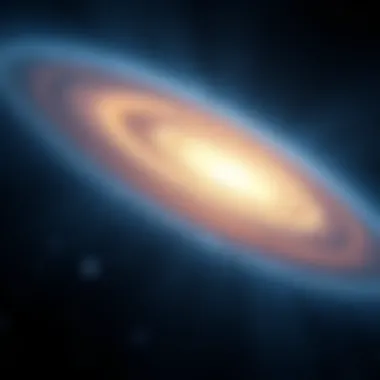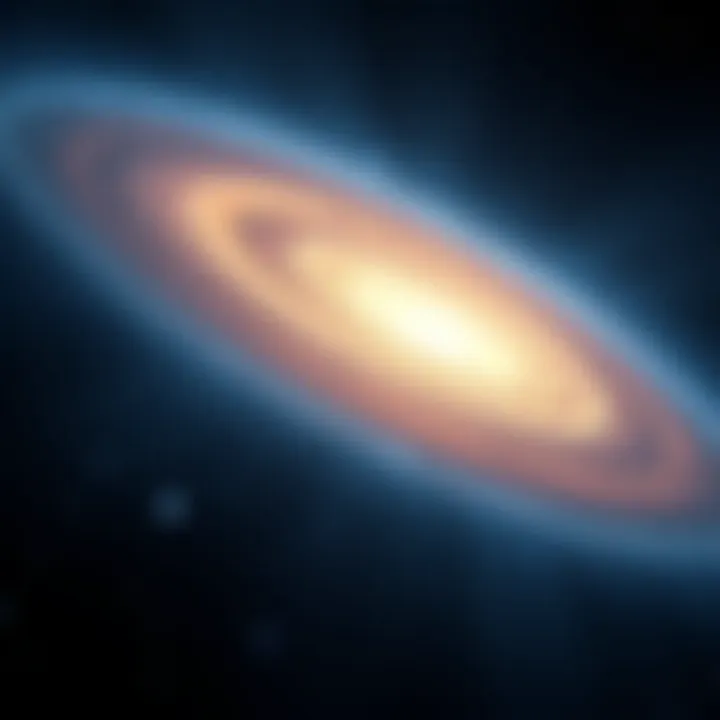Astrophysics Insights for Curious Minds


Intro
Astrophysics is a field that sits at the intersection of physics and astronomy, exploring the fundamental forces and phenomena that govern the cosmos. At its heart, it seeks to understand not just the 'what' of the universe but the 'how' and 'why.' Whether one is enthralled by the shimmering stars in the night sky or captivated by the enigmatic black holes, this discipline provides a framework for deciphering the complexities of the universe.
In this exploration, we will journey through the core concepts that form the bedrock of astrophysics, aiming to strip away the complicated jargon and present the material in a way that sparks curiosity. Instead of drowning in mathematical equations, readers can bask in the wonder of cosmic realities, gaining insights into the forces and entities that sculpt our universe. By mixing foundational theories with the latest discoveries, the aim is to create a panoramic view of astrophysics that engages and informs.
The wonder of this subject matter lies not just in understanding how things work, but in realizing how deeply interconnected we are with everything around us. From the Big Bang to the expanding universe, the tales and theories woven into astrophysics offer a glimpse into the grand tapestry of existence, igniting a desire to further explore the unknown regions of space.
Foreword to Astrophysics
Astrophysics serves as a bridge, connecting our everyday experiences on Earth with the vast, intriguing cosmos beyond our blue sky. This branch of science is not only important for understanding the universe; it plays a crucial role in shaping our comprehension of fundamental physical laws. Whether it's gravity pulling at our feet or the shimmering lights we see at night, astrophysics encapsulates the essence of the universe in a way that is accessible to anyone with a curious mind.
By delving into astrophysics, readers can unlock a treasure chest of knowledge. The study of celestial bodies, cosmic events, and the underlying forces governing them can enrich one's perspective on life and existence itself. It's where science meets philosophy, offering answers to age-old questions about our place in the cosmos. Astrophysics is about examining the grand design of the universe—how it began, how it's structured, and where it's going.
Defining Astrophysics
Astrophysics can be simply defined as the branch of astronomy that uses the principles of physics to understand how stars, galaxies, and various celestial entities operate. This definition, however, barely scratches the surface.
In more detail, astrophysics seeks to answer questions related to the nature and behavior of astronomical objects—be it a swirling galaxy millions of light-years away or a small asteroid hurtling through space. By employing theoretical frameworks and experimental observations, astrophysicists aim to piece together the puzzle of the universe.
Astrophysics can be broadly divided into two major categories. First, there's theoretical astrophysics, which revolves around developing models and simulations to explain observed phenomena. Then there's observational astrophysics, which involves gathering data through telescopes and sensors to validate or challenge existing theories.
Historical Context and Development
The journey of astrophysics stretches back to ancient times, where civilizations like the Babylonians and Greeks laid the groundwork. These early scholars were not equipped with advanced technology, yet they observed the night sky and recorded celestial events, such as eclipses and the positions of constellations.
Fast-forward to the Renaissance, a period marked by groundbreaking advancements in mathematics and technology. Astronomers such as Copernicus and Galileo began to shift perspectives on the structure of the solar system, challenging the geocentric model that had long prevailed. The invention of the telescope was a game-changer, enabling observation of planets and stars with unprecedented detail. It was during this era that the laws of planetary motion were formulated, laying the groundwork for Newton's law of gravitation.
The 20th century ushered in a new era, with the advent of modern astrophysics. Key developments such as the discovery of the cosmic microwave background radiation in the 1960s corroborated the Big Bang theory, fundamentally altering our understanding of the universe's origin. Since then, technological advancements, such as space telescopes and satellite observatories, have opened new vistas for exploration, unveiling the mysteries that lay beyond our home planet.
As we look to the future, the field continues to evolve in response to new findings and methodologies, constantly reshaping our comprehension of the cosmos. Each advancement draws from a rich history—one that showcases humanity's relentless quest for knowledge about the universe.
Cosmology: The Universe's Structure
Cosmology serves as a cornerstone in understanding the universe in which we dwell. This field not only deals with the cosmos on a grand scale but also invites us into the intricate connections between space, time, and matter. By unraveling the universe's structure, we begin to grasp essential principles that govern everything from galaxies to the very fabric of spacetime. Understanding cosmology enriches our perspective on existence and engages our natural curiosity about the cosmos and our place within it.
The Big Bang Theory
When we talk about cosmology, one method that stands out is the Big Bang Theory. It attempts to provide a coherent narrative about how the universe sprang into being from a hot, dense state roughly 13.8 billion years ago. Picture it – everything compacted into a singular point, and then, in an astonishing flash, the universe began expanding. The enormity of this concept can be mind-boggling. However, it lays the groundwork for how we perceive the cosmos today.
The Big Bang Theory explains not just the origins of space but also its expansion. This isn't just a fancy story; it’s supported by various lines of evidence, including the observed redshift of distant galaxies, indicating they are moving away from us, and the distribution of galaxies across the universe. This has led to the idea that the universe is not static; it’s very much alive and constantly expanding, almost like a rubber band stretching out, getting bigger with every second.
Cosmic Microwave Background Radiation
Another key player in the field of cosmology is the Cosmic Microwave Background Radiation (CMB). Think of this as an echo from the dawn of time, emerging from the chaotic mess of the early universe. Roughly 380,000 years after the Big Bang, the universe cooled enough for protons and electrons to combine into hydrogen atoms. At that point, photons, or light particles, started their journey through space. This radiation, which fills the universe, has been traveling ever since in all directions.
The CMB is a treasure trove for cosmologists. It provides a snapshot of the early universe, showcasing slight temperature variations that hint at the seeds of all cosmic structures we see today. The study of these tiny fluctuations enables scientists to glean insights into the age, composition, and expansion of the universe, acting almost like a cosmic map showing how structures evolved.
Dark Matter and Dark Energy
Venturing into one of the most intriguing aspects of cosmology, we arrive at Dark Matter and Dark Energy. These concepts feel almost like science fiction, yet they form the backbone of our understanding of the universe's behavior. Dark Matter is believed to account for about 27% of the universe, but here's the kicker: we can’t see it. It doesn’t interact with electromagnetic forces, meaning it doesn’t emit, absorb, or reflect light. So how do we know it exists? The evidence comes from its gravitational effects on visible matter, radiation, and the large-scale structure of the universe.
On the other hand, Dark Energy constitutes about 68% of the universe. This enigmatic force is believed to be responsible for the acceleration of the universe’s expansion. It’s almost as if something is pushing the universe apart faster and faster. The nature of Dark Energy remains one of the greatest mysteries in modern astrophysics and cosmology.
"The universe is not only queerer than we suppose, but queerer than we can suppose." — J.B.S. Haldane
These concepts challenge our understanding, pushing the boundaries of what we think we know about physics. They beckon us to consider the cosmos in an entirely new light, reminding us that even our most meticulous theories could change tomorrow.


Stellar Evolution: Life Cycle of Stars
Understanding the life cycle of stars is fundamental to astrophysics. It sheds light on the origins of the elements we find on Earth, the formation of galaxies, and the ultimate fate of our universe. The process of stellar evolution unfolds over billions of years, reflecting the complex interactions between gravity, nuclear fusion, and thermodynamics.
The journey of a star begins in a nebula, a vast cloud of gas and dust. Studying the stages of stellar evolution allows us to comprehend how stars influence their surroundings, trigger the birth of new stars, and contribute to cosmic recycling.
Birth of a Star: Nebulae
Nebulae serve as the birthplaces of stars, where dense regions of gas and dust gather under their own gravity. These clouds, primarily composed of hydrogen and helium, can stretch for light-years and foster diverse conditions.
- Gravitational Collapse: Eventually, areas within a nebula begin to collapse, leading to a concentration of matter. As gravitational forces tighten, temperatures rise; this is the first step towards star formation.
- Protostar Formation: As the core contracts further, a protostar is formed. This phase is characterized by the buildup of pressure and heat until nuclear fusion ignites. The birth marks the transition from potential energy to luminescence.
In essence, a nebula is not just a cloud in space but rather the cradle of stars, wherein the dance of particles leads to the formation of celestial bodies.
Main Sequence Stars
Once nuclear fusion begins, a star enters the main sequence phase, where it spends most of its life—often billions of years. The balance between gravitational collapse and the outward pressure from fusion reactions gives these stars remarkable stability.
- Hydrogen Fusion: During this stage, hydrogen at the core fuses into helium, releasing immense amounts of energy. Stars like our Sun fall into this category, providing light and warmth necessary for life on Earth.
- Equilibrium: The balance between gravity and radiation pressure ensures the star remains steady. This stability defines the star’s characteristics, including its size, color, and brightness.
Understanding the main sequence is crucial, as it reflects the star's current state and its potential evolution later on.
Red Giants and Supernovae
As stars exhaust their hydrogen fuel, they shift towards the next chapter of their journey. Stars larger than our Sun expand into red giants.
- Expansion Phase: The core contracts under gravity, raising temperatures high enough to fuse helium into heavier elements, leading to the star's significant increase in size.
- Dramatic Finale: For massive stars, this phase culminates in a spectacular supernova explosion, dispersing elements into space and enriching the interstellar medium. Elements forged in the hearts of these stars pave the way for new star and planet formation, exemplifying cosmic recycling.
The life and death of a star underscore the intricate cycles within our universe, revealing the delicate balance of creation and destruction.
Black Holes and Neutron Stars
The fate of a star depends largely on its mass, leading to fascinating endpoints: black holes or neutron stars.
- Neutron Stars: If the remaining core after a supernova is between 1.4 and 3 solar masses, it becomes a neutron star, astonishingly dense and small. Just a sugar-cube-sized amount of a neutron star would weigh as much as a mountain on Earth.
- Black Holes: For stars exceeding 3 solar masses, their collapse leads to a black hole, a region in space where gravity is so strong that nothing can escape, not even light. This phenomenon pushes the boundaries of our understanding of physics.
These remnants shape the future of galaxies, influencing how matter interacts across vast distances in the cosmos.
"The life cycle of stars is the ultimate cosmic narrative, shaping and reshaping the universe as we know it."
In summary, the phenomena of stellar evolution provide profound insights into the workings of the universe. From their birth amidst nebulae to their dramatic ends, stars forge the very elements of life, driving the dynamic ebb and flow of cosmic existence. The study of their lifecycle opens a window into understanding our place in the universe, bridging the gap between the stars and our very own existence.
For more on stellar evolution, check out these resources: NASA - Stellar Evolution and Wikipedia on Stellar Evolution
Galaxies: The Building Blocks of the Universe
Galaxies serve as the fundamental components that make up our universe. They are vast assemblages of stars, gas, dust, and dark matter, all bound together by gravity. Understanding galaxies is not just an exercise in cosmic bookkeeping; it’s a key to unraveling the mysteries of the universe. From their formation to their interactions, galaxies offer insight into how the universe has evolved. In essence, studying galaxies equips us with the tools to comprehend the sprawling architecture of cosmic phenomena.
Types of Galaxies
Galaxies can be broadly classified into several types, each with distinct characteristics. The classification is essential to understanding their formation and the behaviors they exhibit. The three main types are:
- Spiral Galaxies: These galaxies, like our own Milky Way, feature flat, rotating disks containing stars, gas, and dust, and they are characterized by spiraling arms. They typically host a lot of young stars and are sites of ongoing star formation.
- Elliptical Galaxies: Ranging from nearly spherical to elongated shapes, elliptical galaxies have less structure than spiral galaxies and contain older stars with minimal ongoing star formation. Their smooth appearance and aging population often indicate a mature system that has merged with others over time.
- Irregular Galaxies: These galaxies lack a defined structure and include those that may be in the process of merging or have undergone gravitational interactions with neighboring galaxies. Their chaotic form makes them important for studying the dynamics of galaxy formation and evolution.
Each type of galaxy contributes uniquely to our understanding of cosmic history, indicating how stars, gas, and even dark matter evolve over time.
Intergalactic Space and Dark Matter
Intergalactic space, the vast void that exists between galaxies, is not merely empty. This region is filled with low-density gas and is a domain where dark matter predominates. Dark matter, despite being invisible, plays a crucial role in the universe.


Dark matter interacts with normal matter through gravity but does not emit, absorb, or reflect light, making it undetectable by traditional means.
The gravity from dark matter helps galaxies to form and hold together, influencing their motions and interactions. Although we can't see dark matter directly, its effects are evident in the way galaxies behave, from their rotations to how they cluster together. As researchers learn more about dark matter, they are uncovering the larger structure of the universe and how it has evolved from the Big Bang to the present day.
Understanding intergalactic space and dark matter is essential for a comprehensive grasp of galaxy dynamics and the universe’s overall composition. Each discovery enriches our knowledge and propels further inquiry into the cosmos.
For more on the types of galaxies, you can visit NASA. The complexities of dark matter are comprehensively discussed at Wikipedia.
Exoplanets: Worlds Beyond Our Own
Exoplanets, or extrasolar planets, play a pivotal role in our understanding of the universe. These celestial bodies orbit stars outside of our solar system and, in many cases, they could potentially host life. The growing interest in exoplanets stems from both scientific curiosity and the inherent desire to find out whether we are alone in the cosmos. This section delves into the methods of detecting exoplanets and explores the intriguing possibility of life beyond Earth, enriching our perception of astrobiology and contributing to the broader narrative of cosmic exploration.
Methods of Exoplanet Detection
Detecting exoplanets is not a walk in the park. It requires a combination of creativity, technological advancement, and a bit of luck. Several methods have been developed, each with its own strengths and limitations:
- Transit Method: The most widely used technique. As a planet crosses in front of its host star, it temporarily blocks a fraction of the star's light, causing a dip in brightness. This can be monitored from Earth and reveals the planet's size and orbit.
- Radial Velocity Method: This method looks for wobbles in a star's motion caused by the gravitational pull of an orbiting planet. By measuring shifts in the star’s spectrum, scientists can infer the planet's mass and distance.
- Direct Imaging: A challenging approach that aims to capture images of the planets themselves. This involves using powerful telescopes to distinguish the faint light from a planet against the overwhelming brightness of its star.
- Gravitational Microlensing: An innovative technique that utilizes the effect of gravity on light. When a massive body passes in front of a distant star, it can bend the light from that star, creating a temporary brightening, which may indicate the presence of a planet.
Each of these techniques provides unique insights, and the continuous advancement in technology boosts our ability to discover more exoplanets each year.
Many exoplanets reside in what scientists call the ‘habitable zone’—the region around a star where conditions may be right for liquid water, a key component for life as we know it, to exist.
Potential for Life on Exoplanets
The search for life on exoplanets is one of the most tantalizing prospects in modern astrophysics. As we look into the vastness of space, the existence of potentially habitable worlds raises profound questions regarding life's origins and diversity.
- Conditions for Life: For a planet to be considered habitable, it typically needs to be in the
Astrophysical Instruments and Techniques
Astrophysics relies heavily on sophisticated instruments and techniques that allow scientists to explore the universe. These tools not only enhance our understanding of celestial phenomena but also enable us to gather crucial data that informs theories and aids in uncovering cosmic mysteries. There are several critical areas within this realm, specifically focusing on telescopes and spectroscopy, which significantly play roles in how we observe and understand the cosmos.
Telescopes and Their Functionality
Telescopes are the backbone of observational astrophysics. They function by collecting and magnifying light from distant celestial objects, making it possible for astronomers to study anything from nearby planets to galaxies billions of light-years away. Without these instruments, our understanding of the universe would be as blind as a bat. There are distinct types of telescopes, each with unique capabilities:
- Optical Telescopes: They focus on visible light and are the most commonly recognized type. They can be further divided into refractors, which use lenses, and reflectors, which utilize mirrors to gather light.
- Radio Telescopes: These telescopes capture radio waves emitted by astronomical objects. They play a crucial role in studying phenomena such as pulsars and cosmic background radiation.
- Space Telescopes: Located beyond Earth's atmosphere, these telescopes like the Hubble Space Telescope can observe the universe without atmospheric interference. This clarity yields much sharper images than ground-based telescopes can achieve.
Each of these telescopes serves specific purposes, and their combined usage allows for a more comprehensive view of the cosmos. Understanding their functionality can make anyone feel like they’ve taken a leap into the future of space exploration.
"The only thing more exciting than the planets and stars themselves is the tools we’ve built to see them."
Spectroscopy and Observational Methods
Spectroscopy is another vital technique that astronomers employ to decipher the universe. By analyzing the spectrum of light emitted or absorbed by objects in space, scientists can glean a wealth of information. This method reveals numerous characteristics about celestial bodies, such as their temperature, composition, and velocity. Spectroscopy operates on the principle that every element produces a unique signature of spectral lines. Some critical points to consider about spectroscopy include:
- Chemical Composition: By looking at the light spectrum from an object, astronomers can tell what materials are present, which is essential when searching for exoplanets.
- Doppler Effect: This phenomenon allows astronomers to determine the movement of stars and galaxies relative to Earth. Their light shifts toward red or blue based on their motion—this shift acts like a cosmic speedometer.
- Temperature Measurement: The pattern of light emitted enables calculations of surface temperatures. The hotter the object, the shorter the wavelength of light it emits, providing insights into stellar properties.
Observational methods, complemented by spectroscopy, allow researchers to conduct in-depth analyses of various phenomena. This combination of instruments and techniques ushers in new horizons, facilitating the continual quest to unravel the secrets of the universe.
For further insights and more technical details on these instruments, you may explore resources such as Wikipedia and Encyclopedia Britannica.
The Role of Mathematics in Astrophysics
Mathematics serves as the bedrock of astrophysics. Without it, many of the universe's mysteries would remain unsolved, lost in the vast expanse of our inability to quantify the cosmos. In astrophysics, mathematicians and physicists work hand in hand, utilizing equations and models to comprehend complex phenomena ranging from the smallest particles to the largest galaxies. The importance of mathematics in this field cannot be overstated; it transforms abstract theories into tangible insights, paving the way for understanding and discovery.
The Importance of Mathematical Models
Mathematical models are crucial in astrophysics for several reasons. They provide a schematic representation of physical systems that allow scientists to predict and analyze the behavior of celestial bodies. A great example is the orbital mechanics governing the movement of planets around the sun. This discipline, developed by Kepler and later solidified by Newton, hinges on mathematical formulations that describe elliptical orbits.


Moreover, models can simulate phenomena that are difficult or impossible to observe directly. Take black holes, for instance. While we can’t observe black holes with our eyes, mathematical models help us understand their properties and implications, leading to a deeper grasp of gravitational physics. The famous equation, E=mc², is a concise mathematical statement of the equivalence between mass and energy, foundational for understanding nuclear reactions and stellar evolution.
Mathematics also helps in refining observational techniques. For instance, using algorithms that analyze data from telescopes allows astronomers to extract meaningful information from volumes of starlight. Such techniques underscore the intricate relationship between data and mathematical theory.
Statistics in Astronomical Research
Statistics plays an equally significant role in astrophysics, acting as the lens through which observational data are interpreted. The universe is vast and varied, but understanding it requires sifting through immense datasets. Here, statistical methods come into play, helping researchers discern patterns from the noise.
Astrophysical surveys, such as the Sloan Digital Sky Survey, gather billions of data points regarding celestial objects. By employing statistical models, scientists can infer important trends. For instance, they utilize probabilities to predict the distribution of galaxies or the occurrence of exoplanets in different environments.
Moreover, understanding uncertainties is vital in astrophysics. Errors can stem from measurement techniques or natural variabilities in celestial phenomena. Statistical tools enable astrophysicists to quantify these uncertainties and make informed conclusions.
In a nutshell, the intersection of mathematics and astrophysics creates a powerful platform for exploring the universe. Mathematical models facilitate comprehending and predicting celestial phenomena, while statistics enables researchers to derive meaning from observational data. As we venture further into this cosmic age, the analytical prowess of mathematics will undoubtedly continue to illuminate the path for generations of inquisitive minds.
"Mathematics is the language in which the universe is written." - Galileo Galilei
For further exploration into the topics discussed, refer to resources such as NASA and American Astronomical Society.
Current Trends and Future Directions in Astrophysics
Astrophysics is not a static field; it is ever-evolving. The significance of understanding current trends and future directions cannot be overemphasized. As we push the boundaries of knowledge, we grasp not only our universe but also the very fabric of scientific inquiry itself. With advancements in technology and shifts in theoretical thinking, the landscape of astrophysics is changing in fascinating ways. Keeping an eye on these trends can equip curious minds with insights about how humanity seeks to comprehend cosmic puzzles that have eluded us for centuries.
Recent Discoveries and Breakthroughs
In recent times, a series of groundbreaking discoveries have reshaped our understanding of the cosmos. Here are a few notable highlights:
- Gravitational Waves: The detection of gravitational waves by LIGO provided a powerful confirmation of Einstein’s general relativity. This breakthrough opened a new avenue for observing the universe.
- Exoplanets and Atmospheric Studies: The discovery of numerous exoplanets, particularly those in the habitable zone of their stars, has sparked discussions about the potential for extraterrestrial life. Instruments like the James Webb Space Telescope are now analyzing the atmosphere of these distant worlds for signs of habitability.
- Black Hole Imaging: The Event Horizon Telescope successfully captured the first image of a black hole, offering visual proof of these mysterious entities. This achievement pushed the frontier of observational astrophysics to new heights.
- Dark Matter Research: Recent experiments aiming to detect and study dark matter particles suggest we might finally be on the right track to unveil the nature of these elusive components of our universe.
"In astrophysics, every discovery is a new layer of understanding, a key that opens doors to new questions."
These breakthroughs not only enlighten our knowledge but also fuel the excitement surrounding future research. Scientists are now digging deeper into the phenomena that govern stellar life, cosmic evolution, and the very structure of spacetime itself.
Upcoming Missions and Projects
As we stand on the threshold of new endeavors, several missions are set to revolutionize our understanding of astrophysics. Here’s a sneak peek:
- James Webb Space Telescope (JWST): Launched in late 2021, JWST aims to observe cosmic formations and potentially analyze the atmospheres of exoplanets, expanding our grasp of the universe's early history.
- Lunar Gateway: This project will establish a sustainable lunar presence for research and technological testing, paving the way for future missions to Mars and beyond.
- Parker Solar Probe: Designed to study the sun's outer atmosphere, this mission promises to reveal the solar mechanisms that drive space weather and impact our planet.
- Square Kilometre Array (SKA): Once operational, the SKA will be one of the world’s largest radio telescope arrays, capable of conducting deep surveys of the universe's history and aiding in the quest to understand dark energy and dark matter.
The unfolding of such initiatives reflects humanity’s relentless passion for exploration. As these missions gather data and unveil secrets, the field of astrophysics will undoubtedly evolve, solidifying our place within the cosmos.
Finale: The Endless Quest for Knowledge
In a world where knowledge is continuously evolving, the quest for understanding the universe serves as a pivotal journey for humanity. This article has explored fundamental aspects of astrophysics, encouraging the reader to appreciate not only the cosmos but also the intellectual spirit that drives scientific discovery. The significance of enduring exploration cannot be overstated; it serves as a beacon of hope and inspiration for current and future generations.
The Significance of Continuing Exploration
Continuing exploration in astrophysics proves invaluable, fostering innovations that extend our grasp of the universe. Each new discovery, whether it be the detection of exoplanets or insights into cosmic background radiation, expands the borders of our understanding. Engaging with the mysteries of the cosmos keeps the scientific community vibrant, promoting collaborative efforts among researchers and educators alike.
A few benefits of ongoing exploration include:
- Advancement in Technology: The tools and techniques developed for astrophysical studies often yield innovations applicable in other fields, from medicine to engineering.
- Global Collaboration: Astrophysics is a realm where cultures converge to address universal questions, cementing relationships across borders.
- Public Engagement and Education: Sharing discoveries with the public fosters a deeper appreciation of science, inspiring the next generation of curious minds.
"The most exciting phrase to hear in science, the one that heralds new discoveries, is not 'Eureka!' but 'That's funny'."
– Isaac Asimov
With an eye towards the future, continuing exploration is essential in maintaining momentum in a field where each question tends to lead to multiple others. It ignites curiosity that fuels humanity’s drive to explore the unknown, ensuring we remain connected to the mysteries of existence.
Inviting Future Inquiry
Inviting future inquiry is crucial for pushing the boundaries of what we know. Each question posed sparks new hypotheses and inspires inventive paths for exploration. Educators and researchers alike have the responsibility to not only engage in current discussions but also encourage inquisitive minds in their pursuit of understanding.
To foster an environment of inquiry, consider:
- Incorporating Astrophysics into Education: Making cosmic concepts part of the school curriculum can pique students' interests early on, potentially guiding them towards careers in science.
- Public Forums and Lectures: Creating platforms where expert discussions can occur invites community involvement and investment in the scientific process.
- Online Resources and Engagement: Utilizing social platforms and educational websites ensures. people can stay updated with the latest findings and discussions around astrophysics.
The openness to new questions and explorations fosters a rich atmosphere necessary for breakthroughs. By nurturing an inquisitive spirit and remaining open to learning, we not only advance knowledge but also contribute to the communal understanding of our universe.



